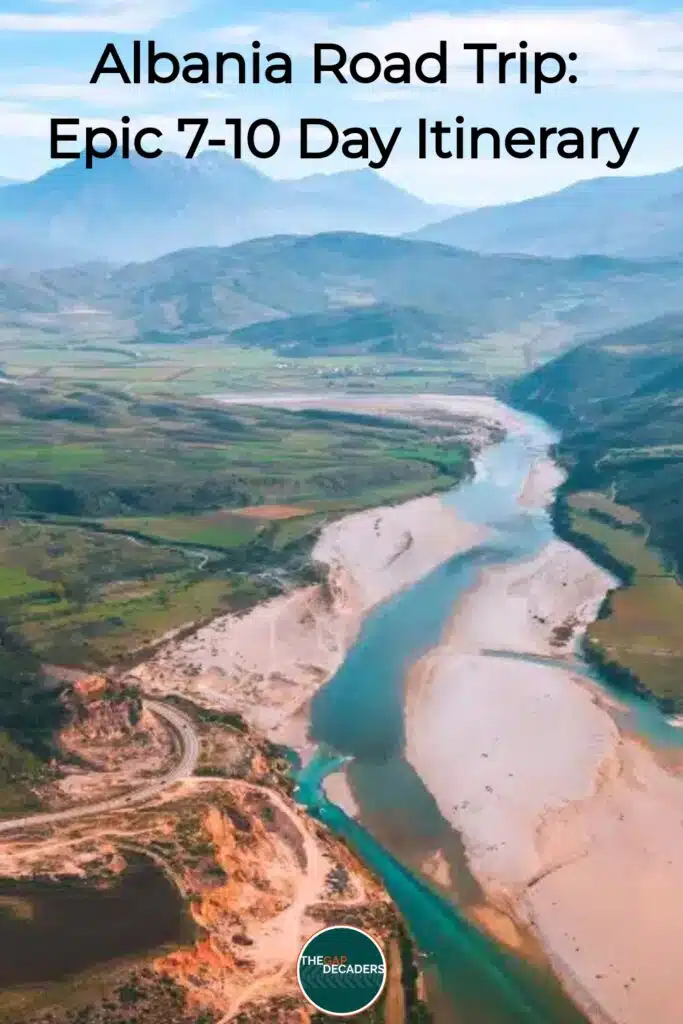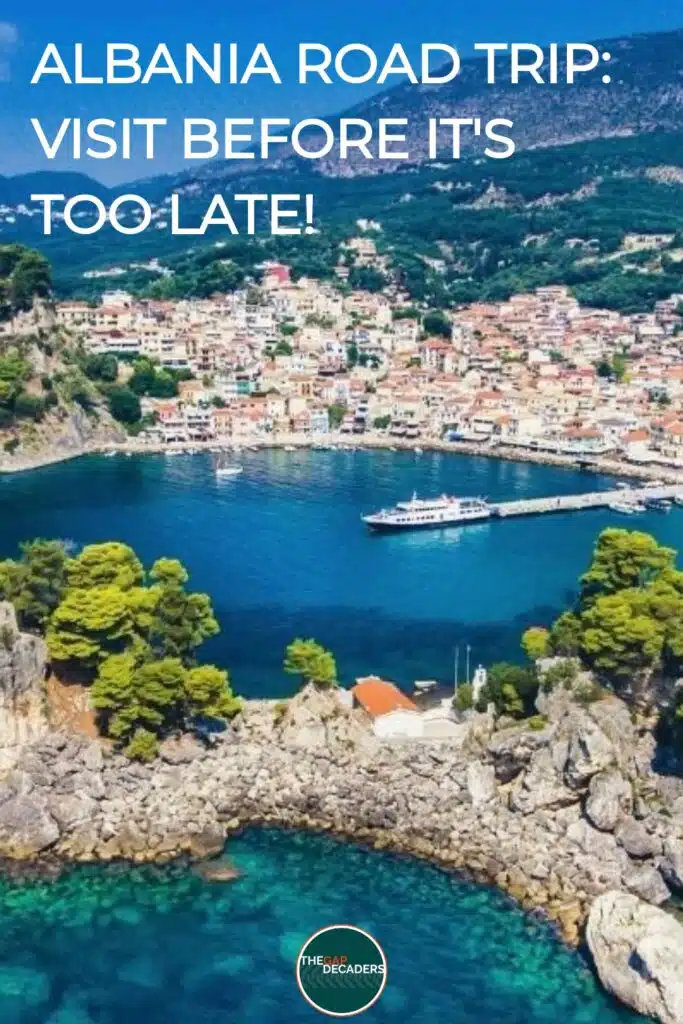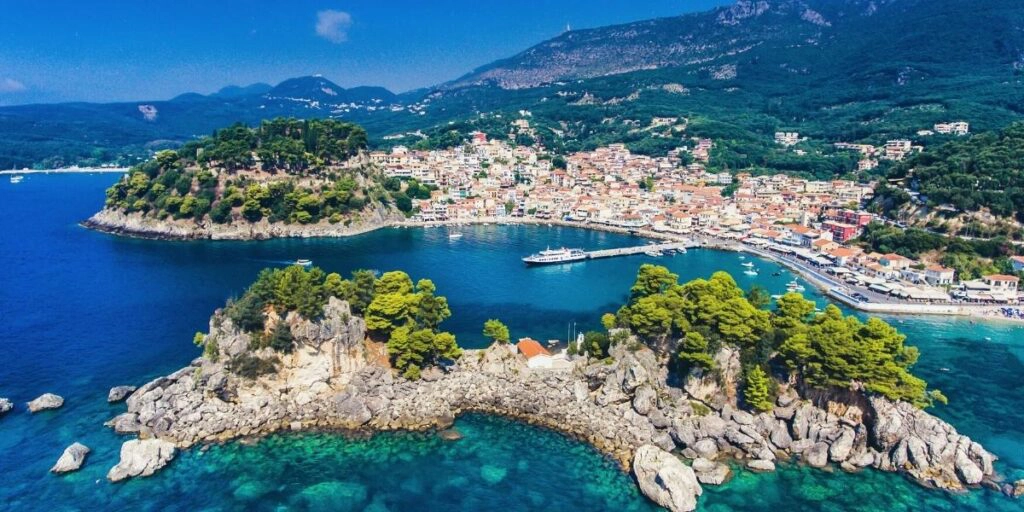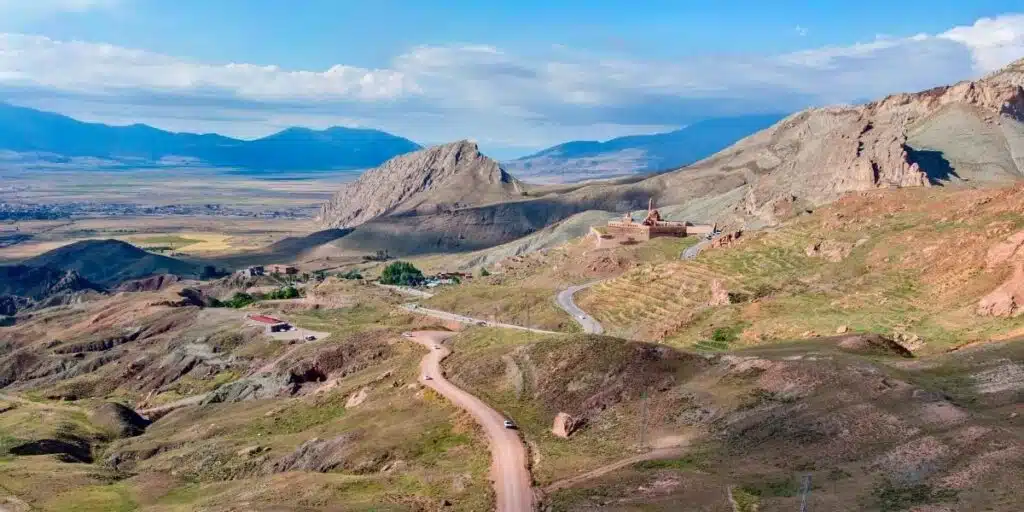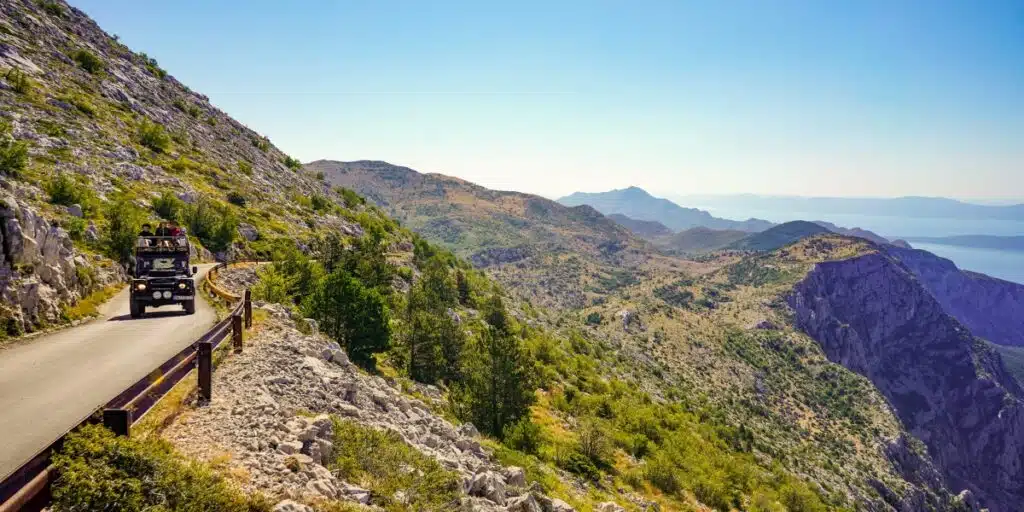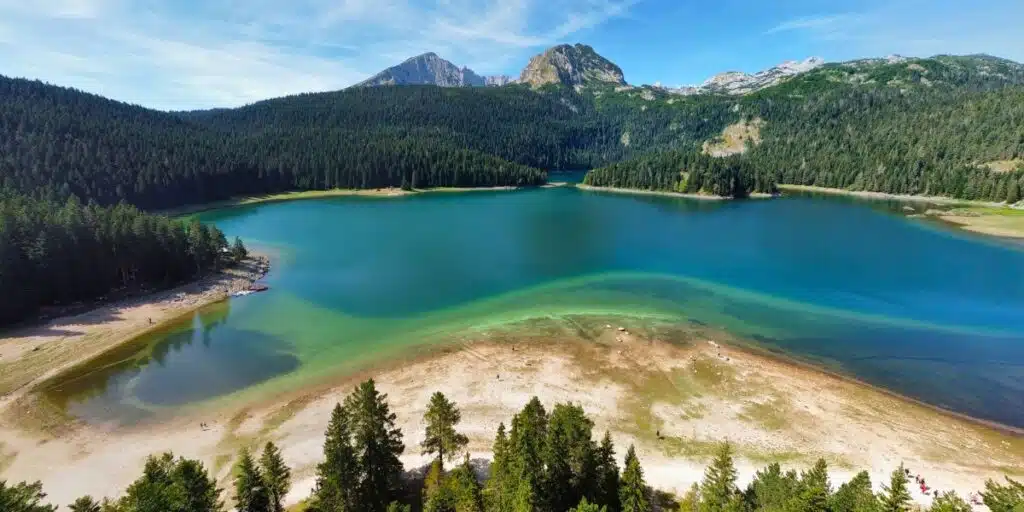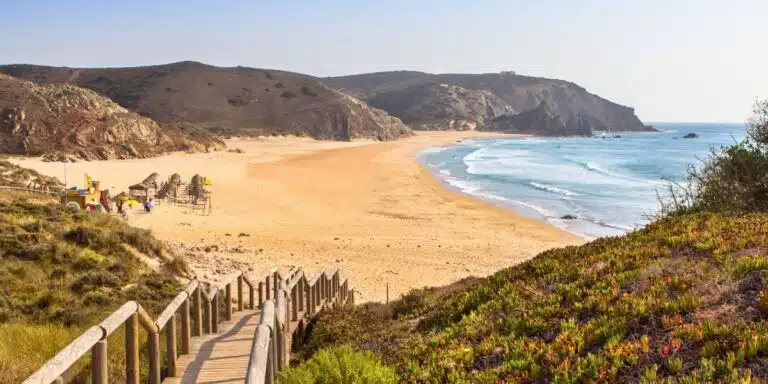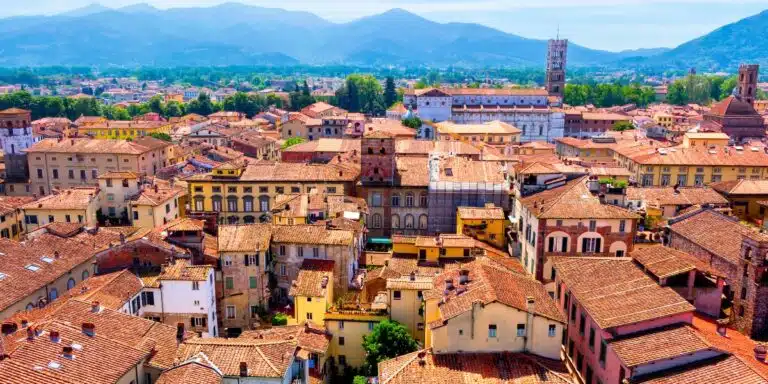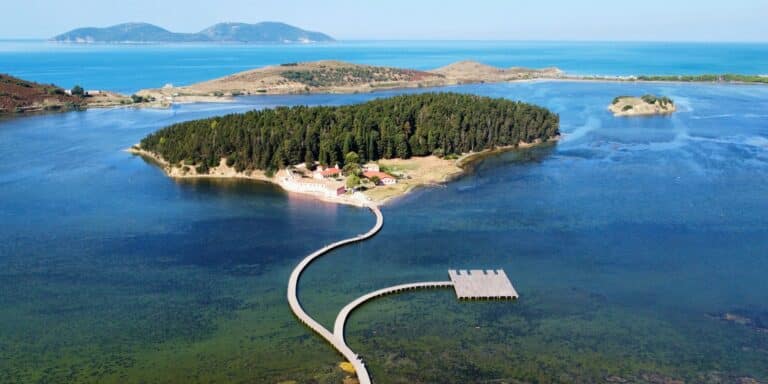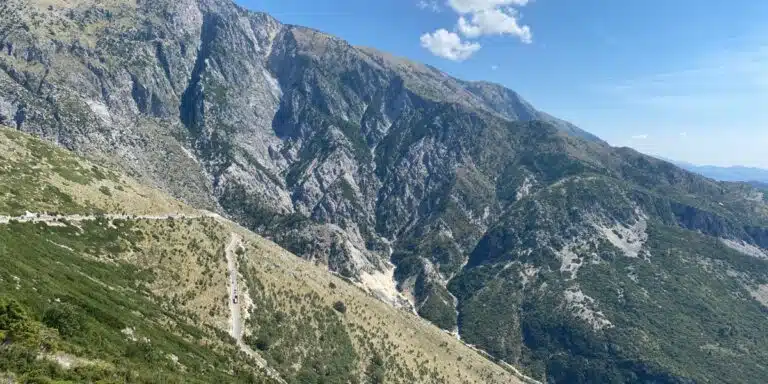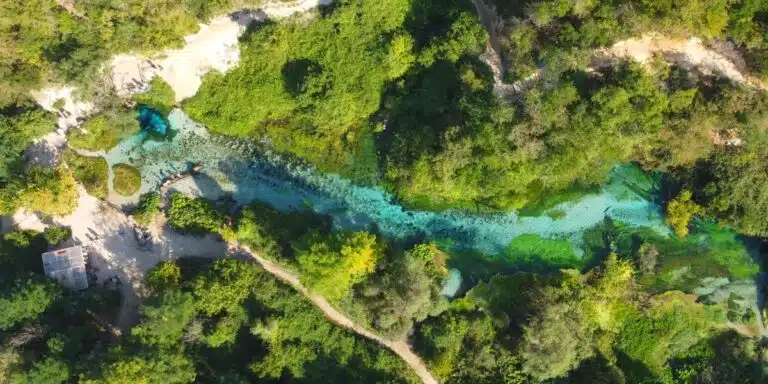This post may contain affiliate links, from which we earn an income. Click here to read our affiliate policy.
Ultimate Albanian road trip planner
Are you ready for an unforgettable adventure? Pack your bags and visit Albania, where breathtaking scenery, Ottoman architecture, exceptional food, and off-the-beaten-path places await.
We spent three months touring Albania in our overland truck as part of a longer Europe road trip, but you can see all the best bits in an action-packed seven to ten days. From the stunning Albanian Alps to the turquoise waters of the Ionian Sea, our Albania travel guide will take you to the charming villages, ancient ruins, vibrant cities, and UNESCO sites we discovered on our incredible road trip of the Balkans’ most exciting country and one of our favorites in Europe.
In this Albania travel planner, we’ll share the best itinerary, insider tips, must-see destinations, and practical advice to help you plan your own epic adventure. Whether you’re a seasoned traveler or a first-time explorer, a road trip in Albania is an experience you won’t want to miss.
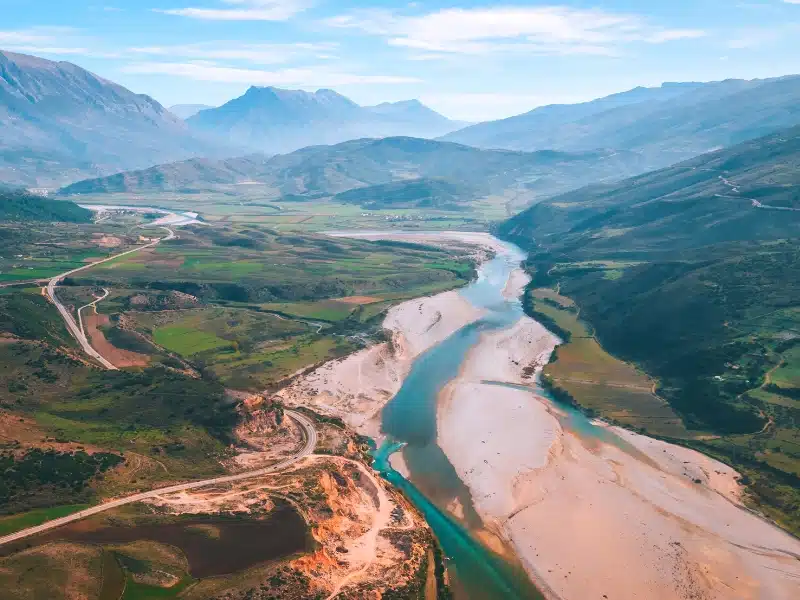
Where is Albania?
The Republic of Albania is a small, mountainous country in south-eastern Europe’s Balkan Peninsula, bordering the Adriatic Sea to the west, the Ionian Sea to the south, and with land borders to Greece in the south, the former Yugoslav Republic of Macedonia in the east and Montenegro and Kosovo in the north.
Albania’s landscape ranges from the snow-capped mountains in the Albanian Alps and the Korab, Skanderberg, Pindus, and Ceraunian Mountains to the tropical hot and sunny beaches and turquoise waters of the Mediterranean, making it a must-visit country on any Balkans travel itinerary.
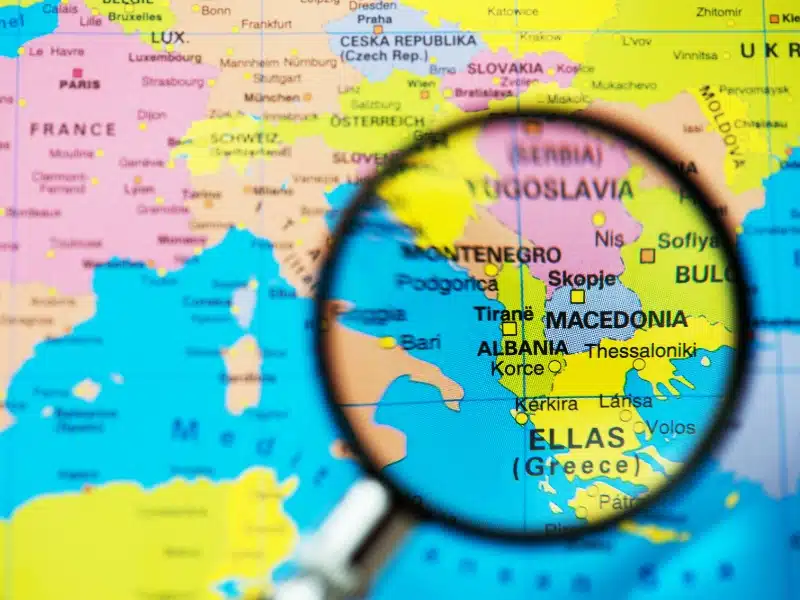
Is It Safe to Visit Albania?
Albania is geographically in Europe but not in the European Union and is a bit off the beaten track. This makes an Albania vacation a great opportunity for adventure, and you’ll still find a real sense of wilderness, especially if you head inland or into the so-called Accursed Mountains.
Unfortunately, Albania has gained a somewhat unfair reputation as a crime-ridden nation, but in fact, it’s safe to travel to Albania. In fact, statistics show that Albania is just as safe as many other top European destinations. There are mild threats, but nothing that should stop you from visiting and having an amazing time.
Do pay attention to personal and vehicle security as you travel Albania, and avoid any political rallies or demonstrations, which can flare up quickly. Crime and violence do occur in some areas but are not typically targeted at foreigners.
We felt very safe for the whole three months we spent in Albania and found the people to be incredibly friendly and welcoming, and eager to share their beautiful country.
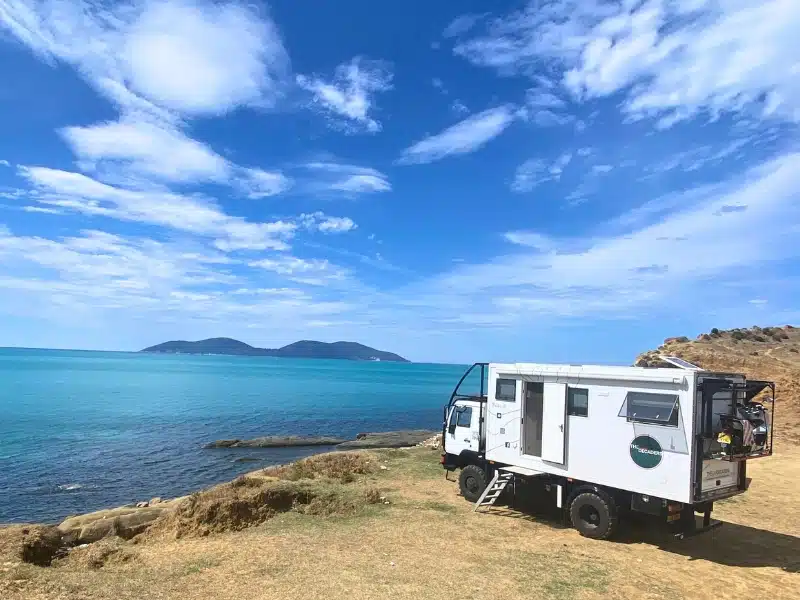
Albania Road Trip Itinerary
This 7 to 10 day road trip from Tirana hits all the Albania bucket list highlights, with eclectic towns and cities, communist and Ottoman history, castles and palaces, and natural wonders on the itinerary.
Our Albania itinerary easily extends to two weeks if you prefer slow travel and taking in more sights as you go. Why not spend longer in your favorite places and check the interactive map for attractions and landmarks nearby?
7 Day Albania Itinerary
10 Day Albania Itinerary
Albania Road Trip Map
How to use this Albania roadtrip map – Use your fingers (or computer mouse) to zoom in and out. Click or touch the icons to get more info about a place, and click the arrow in the box top left to open the index. To add to your own Google Maps account, click the star next to the title of the map.
Day 1: Tirana to Durrës
Tirana
Tirana, the fascinating capital of Albania, is a curious blend of history, culture, and modernity. Known for its eclectic mix of Ottoman, Fascist, and Soviet-era architecture, it’s a city shaped by its turbulent communist past and energized by a dynamic social scene. As the heart of Albania, Tirana is the perfect starting point for your unforgettable road trip itinerary through this stunning Balkan nation.
Kick off your exploration in Skanderbeg Square, the bustling centerpiece of Tirana. This expansive plaza, named after Albania’s national hero, Gjergj Kastrioti Skanderbeg, is surrounded by some of the city’s most iconic landmarks. The National History Museum offers a deep dive into Albania’s complex past, showcasing everything from ancient Illyrian artifacts to post-communist art.
Nearby, you’ll find the Et’hem Bey Mosque, a beautiful Ottoman-era structure famous for its intricate frescoes depicting nature scenes, which is unusual for Islamic art. Despite being closed during the communist era, it survived and reopened as a symbol of religious freedom.
Don’t miss a visit to Bunk’Art 2 Museum, located just off the square. This eerie yet captivating museum is housed in a former nuclear bunker built during the paranoid reign of Enver Hoxha. Inside, you’ll find immersive exhibits detailing Albania’s communist era, with a particular focus on political persecution and daily life under the regime.
From the square, you can also admire the Clock Tower, a Tirana landmark dating back to 1822, and the commanding statue of Skanderbeg, a medieval Albanian military commander celebrated for his successful rebellion against the Ottoman Empire in 1450. Skanderbeg remains a revered symbol of resistance and national pride.
Head over to the Enver Hoxha Pyramid, a striking building originally constructed as a mausoleum for Albania’s longtime communist leader. Although its purpose has shifted over the years, the structure itself remains an intriguing example of Brutalist architecture. Recently renovated, it now serves as a cultural and artistic hub, hosting exhibitions, performances, and other creative events.
If you’re looking to dive into the local culture, visit the bustling Pazari i Ri. This vibrant market is one of Tirana’s oldest, where you can wander through colorful stalls brimming with fresh produce, spices, traditional Albanian foods, handcrafted goods, and souvenirs. It’s a sensory overload but in the best possible way!
For breathtaking views, take a cable car ride to Mount Dajti, the lush green mountain that towers over the city. The 15-minute journey on the Dajti Ekspres, the longest cable car ride in the Balkans, will treat you to panoramic views of the city and the surrounding countryside. At the top, indulge in a delicious lunch at Restaurant Ballkoni Dajtit, where sweeping vistas at over 1,000 meters (3,280 feet) above sea level create a memorable dining experience.
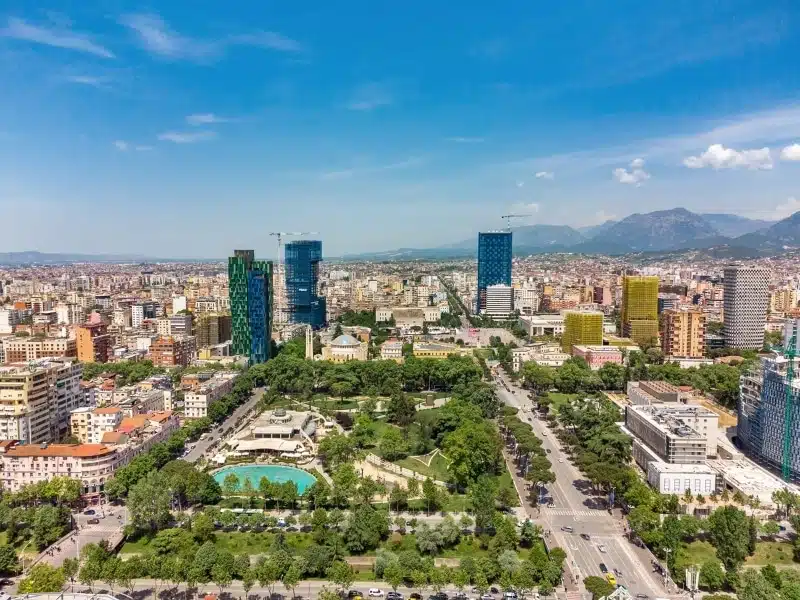
Durrës
Less than an hour’s drive west of Tirana lies Durrës, a bustling coastal city celebrated for its golden beaches, rich history, and vibrant atmosphere. As Albania’s largest port city and one of its oldest, Durrës offers a captivating blend of ancient ruins, charming seaside views, and modern-day cultural experiences.
Start your exploration at the Durrës Amphitheater, a remarkable relic of the Roman Empire dating back to the 2nd century CE. Once capable of seating up to 20,000 spectators, this amphitheater was among the largest in the Balkans. As you wander through its labyrinthine passages and underground chambers, imagine the thrilling gladiatorial battles and grand performances that once captivated audiences here.
Just a short walk away, you’ll find the Venetian Tower of Durrës Castle, a striking remnant of the city’s fortified defenses. Originally constructed in the 5th century and later reinforced by the Venetians, this tower offers panoramic views of the bustling city and the shimmering Adriatic Sea. Climb to the top for a perfect photo opportunity before continuing your journey through history.
For a deeper dive into Durrës’ ancient past, visit the Archaeological Museum, the largest of its kind in Albania. Located near the waterfront, this museum houses a fascinating collection of artifacts from the ancient city of Dyrrhachium – one of the most significant cities in the Roman Empire’s Adriatic provinces. Admire beautifully preserved pottery, jewelry, statues, and mosaics that provide insight into the area’s rich cultural tapestry spanning millennia.
After soaking in the history, enjoy the relaxed charm of the Durrës seaside promenade. This bustling waterfront area is popular for walking, jogging, or biking, offering scenic views of the sparkling sea. If you prefer to unwind, stretch out on Durrës Beach, a seemingly endless stretch of soft sand and crystal-clear waters that spans a whopping six miles. The beach is lined with lively bars, cafés, and restaurants, perfect for grabbing a refreshing drink or snack between sunbathing sessions.
As the sun begins to set, treat yourself to dinner at Cosmo Restaurant or Restaurant Arberia for great beach views. Both establishments offer superb cuisine paired with spectacular beachfront views, making for a perfect end to your day in Durrës. Whether you’re indulging in fresh seafood or sampling traditional Albanian dishes, you’re in for a culinary delight.
If your visit aligns with August, you’re in for an extra treat: the Durrës International Film Summer Festival. This annual cultural event draws filmmakers and enthusiasts from across the globe for a celebration of cinema, creativity, and storytelling. With screenings held under the stars by the sea, it’s an unforgettable experience that showcases the city’s thriving arts scene.
Where to Stay in Durrës
Upmarket: Stay at Hotel Villa Pascucci for its luxurious ambiance, elegant architecture, and serene garden views, offering a tranquil escape just minutes from the bustling city center.
Mid-Range: Stay at Hotel Kloest for its prime location in the heart of Durrës, stylish interiors, and welcoming atmosphere, making it an ideal choice for your stay.
Budget: Stay at Old Town Villa for its charming, boutique-style comfort, personalized service, and convenient proximity to Durrës’ historic sites and beautiful beachfront.
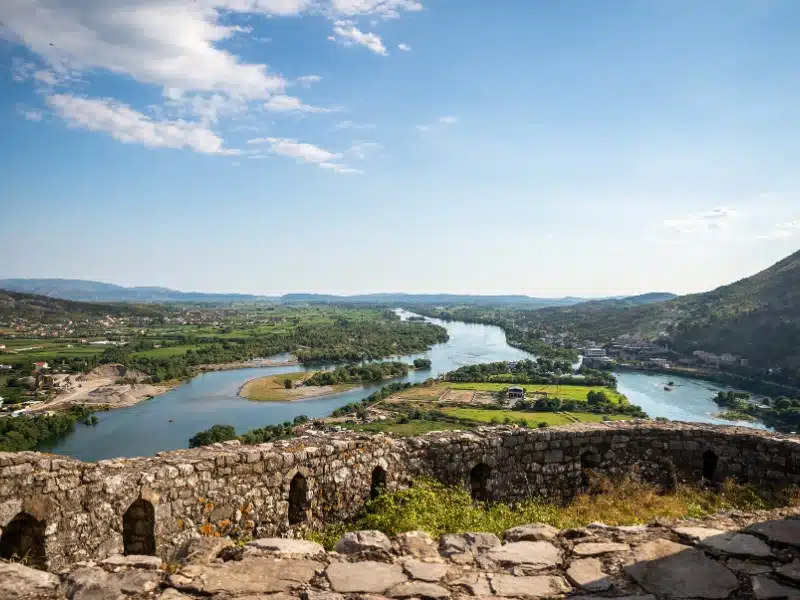
Make sure you have travel insurance you can trust when visiting Albania. We recommend True Traveller for their 5-star TrustPilot reviews, variety of cover options, best activities cover as standard, great prices, and excellent service.
Day 2: Durrës to Vlorë
Berat
Situated along the banks of the Osum River, Berat is a mesmerizing city that effortlessly blends natural beauty with architectural splendor. Located just 60 miles south of Durrës, this UNESCO World Heritage Site is fondly known as the ‘Town of a Thousand Windows’ due to its striking Ottoman-era houses with large, symmetrical windows that seem to gaze out over the city like watchful eyes.
Start your journey by exploring the historic neighborhoods of Mangalem and Gorica, perched on opposite sides of the Osum River. The Mangalem Quarter, once the Muslim district, is famed for its white-washed houses stacked on the hillside, creating a dazzling mosaic of stone, wood, and glass.
Across the river, the Gorica Quarter, traditionally the Christian neighborhood, offers a charming contrast with its own array of quaint, rustic homes and narrow cobblestone streets. Strolling through these neighborhoods feels like stepping back in time, with each turn revealing hidden courtyards, local shops, and picturesque views.
For a deeper insight into the region’s cultural heritage, visit the National Ethnographic Museum in the Mangalem neighborhood. Housed within a beautifully preserved 18th-century Ottoman mansion, this museum showcases a rich collection of traditional clothing, handcrafted tools, household items, and furniture, offering a fascinating glimpse into the daily life of Berat’s past. The setting is a work of art, with intricately carved wood ceilings and authentic period furnishings that enhance the experience.
No visit to Berat is complete without a climb to the Berat Castle, a majestic fortress perched high above the city. Dating back to the 4th century, this impressive stronghold has withstood countless invasions and today offers sweeping views of Berat and the lush Albanian countryside. Unlike many castles, Berat Castle is still inhabited, with locals living within its ancient walls – a living, breathing slice of history.
Within the castle grounds, make sure to visit the Onufri Museum, housed in the 17th-century Church of the Dormition of St. Mary. Named after Onufri, Albania’s most celebrated iconographer, the museum showcases a stunning collection of religious icons and artifacts from the 1500s and beyond. The vibrant, gold-leafed icons are known for their bold colors and intricate detail, showcasing a unique artistic style that reflects both Orthodox and local influences.
After immersing yourself in history, take a leisurely walk along the Osum River to admire the Gorica Bridge, a beautifully preserved Ottoman-era bridge built in the 18th century. Spanning the river with graceful stone arches, it provides picturesque views of both the city and the surrounding hills. As the sun begins to set, the reflection of Berat’s white houses on the river creates a magical, mirror-like effect that’s nothing short of enchanting.

Vlorë
En route to Vlorë, be sure to stop at the ancient Apollonia Archaeological Park, a captivating site that feels like a step back in time. Once a thriving Illyrian city, Apollonia was founded in the 6th century BCE and rose to prominence as a major cultural and economic hub during the Roman era.
Set on rolling hills along the right bank of the Vjosa River and surrounded by lush olive groves, the site’s highlights include the grand theater and the elegant pillars of the restored façade of the city’s 2nd century BCE administrative center. As you wander through the ruins, you’ll feel the echoes of the city’s once vibrant life and its significance in the ancient world.
Once you arrive in Vlorë, start your exploration with a visit to the Independence Museum. This historical landmark commemorates Albania’s declaration of independence from the Ottoman Empire in 1912, an event that holds immense cultural and national significance. The museum is housed in the building where Albania’s Provisional Government was established, and its exhibits provide a powerful insight into the country’s struggle for freedom and the influential figures who led the fight for liberation.
Just a short walk away is the Muradie Mosque, a remarkable structure built in the 1500s under the supervision of Sinan Pasha, the famous Ottoman architect. This ancient mosque is celebrated not only as a place of worship but also as a symbol of Vlorë’s architectural heritage. Its intricate stonework and harmonious design have made it a cherished landmark for both Muslims and non-Muslims.
Next, venture to the 4th-century Kanina Castle, perched on the outskirts of Vlorë. This historic fortress, with its strategic position overlooking the surrounding countryside, played a pivotal role throughout Albania’s history, from the Illyrian era to the Ottoman period. As you explore the castle’s weathered walls and ancient gates, take in the breathtaking panoramic views of Vlorë and the glittering Ionian Sea beyond.
Back in Vlorë, stroll along the city’s lively promenade that stretches along the stunning coastline. Whether you’re drawn to the bustling atmosphere of the cafes and shops or the serenity of the shimmering sea, the promenade is a perfect place to soak in the city’s energy.
If you’re looking to unwind, head to one of Vlorë’s famous beaches—such as Radhima Beach, Orikum Beach, or the more remote but picturesque Dhërmi Beach and Gjipe Beach. With their crystal-clear waters, soft sands, and beautiful sunsets, these coastal gems offer a peaceful retreat or a lively beachside experience, depending on your mood.
Don’t miss a visit to Flag Square, a large public plaza in the center of Vlorë marked by a giant flagpole bearing the Albanian flag. This square, symbolic of Albania’s national pride, is a popular spot for photos and offers a fantastic vantage point for watching the sun dip below the horizon.
To wrap up your day, dine at Te Fabio or Les Amis Restaurant, where you can savor delicious dishes while enjoying breathtaking views of the coast.
Where to Stay in Vlorë
Upmarket: Stay at Hotel Aross for its sleek modern design, stunning sea views, and luxurious amenities. Located near the coastline, it offers convenient access to Vlorë’s famous beaches and a relaxing, upscale retreat after a day of exploration.
Mid-Range: Stay at Mazarine Hotel for its chic decor, stylish rooftop terrace, and exceptional service. Ideally situated close to both the city center and the coast, it provides the perfect blend of comfort and convenience for travelers seeking a sophisticated experience.
Budget: Stay at Maxi Room for its cozy ambiance, personalized service, and prime location. With its welcoming atmosphere and proximity to Vlorë’s main attractions, it’s an excellent choice for visitors looking for a warm and convenient stay.

Other Nearby Road Trips
Day 3: Vlorë to Sarandë
Porto Palermo
Drive to Porto Palermo along the breathtaking Llogara Pass, a legendary coastal road that threads its way through the Ceraunian Mountains, connecting the Dukat Valley in the north with the stunning Albanian Riviera in the south. This scenic route, which reaches a dizzying peak of 1,043 meters (3,422 feet) above sea level, offers panoramic views of rugged mountains, verdant forests, and the sparkling Ionian Sea.
Renowned as a Top Gear favorite, the Llogara Pass is considered one of the most beautiful drives in Albania and a must-see for road trip enthusiasts across Europe. As you navigate the winding SH8 road, you’ll be captivated by sweeping vistas that seem to stretch endlessly into the horizon.
Although the road is fully paved, it presents a thrilling challenge due to its narrow stretches, sharp hairpin bends, and steep gradients of up to 11%. Caution is essential – particularly where barriers are absent – but the reward is a dramatic and unforgettable drive that leaves a lasting impression on every traveler.
Your journey will eventually bring you to Porto Palermo, a charming village nestled along a picturesque bay known for its turquoise waters, rocky beaches, and rich history. The highlight of this coastal gem is the 19th-century Porto Palermo Castle, perched on a small peninsula that juts elegantly into the sea. Built under the orders of Ali Pasha of Tepelena, the castle boasts impressive stone walls and commanding views over the bay. It also played a strategic role as a military base during World War II.
The area is steeped in more recent history, too. You can explore two Cold War-era bunkers that have survived the region’s tumultuous past: the Old Submarine Bunker and the Porto Palermo Tunnel. Both offer fascinating insights into Albania’s defensive strategies during Enver Hoxha’s regime, adding a layer of intrigue to your visit.
When you’re ready to relax, head down to the beach at Porto Palermo. This secluded, rocky beach with clear blue water offers a serene setting for swimming, sunbathing, and soaking up the beauty of the Albanian Riviera. Despite its rugged nature, the beach remains a peaceful and picturesque retreat, with a few small bars and restaurants nearby where you can enjoy a refreshing drink or a light meal.
For a different perspective of the coastline, consider taking a boat tour from Himarë, just a 12-minute drive from Porto Palermo. Most tours will take you to hidden bays, pristine beaches, and secluded coves, many of which are only accessible by boat. It’s a fantastic way to appreciate the dramatic landscape and discover lesser-known gems along the Riviera.
After a morning of exploration, treat yourself to a delicious lunch at Porto Palermo Restaurant. Here, you can savor fresh seafood and traditional Albanian dishes while enjoying breathtaking views of the bay—the perfect way to end your visit before continuing your journey south to Sarandë.

Sarandë
Sarandë is a picturesque coastal town about an hour south of Porto Palermo, known for its sparkling pebbly beaches, lively nightlife, and fascinating ancient archaeological sites. As a gateway to the beautiful Riviera, it’s an Albanian highlight for many.
Start your visit by soaking up the sun at Mango Beach or Gjiri I Midhjeve Beach, two popular spots known for their crystal-clear waters and laid-back ambiance. Whether you prefer lounging on the shore or swimming in the refreshing Ionian Sea, these beaches provide a beautiful introduction to Sarandë’s coastal charm.
For a glimpse into the town’s diverse cultural history, explore the Synagogue Complex. This historic site showcases the region’s rich Jewish heritage, featuring the remains of a synagogue, a Jewish cemetery, and a small museum with exhibits detailing the lives of the Jewish community that once thrived here. The intricate mosaic floors and ancient ruins offer a fascinating peek into the past.
A visit to the Sarandë Archaeological Museum is a must for history enthusiasts. The museum boasts an impressive collection of artifacts from the ancient city of Butrint, a UNESCO World Heritage Site located within Butrint National Park, as well as other nearby archaeological sites. From pottery and coins to statues and ancient tools, the exhibits provide a captivating narrative of the region’s evolving cultures and civilizations.
Another highlight of Sarandë is Lekursi Castle, a medieval fortress perched atop a hill overlooking the town. Originally built by the Ottomans in the 16th century, the castle offers spectacular panoramic views of Sarandë, the Ionian Sea, and even the Greek island of Corfu on clear days. It’s a popular spot for sunset viewing, as the fading sunlight paints the landscape in vibrant hues of orange and gold.
After a day of sightseeing, enjoy a delightful dinner at Hera Restaurant or Balbi 34. Both establishments are celebrated for their fresh seafood dishes and cozy atmospheres, making them ideal choices for a relaxing meal with views of the glistening coast.
Where to Stay in Sarandë
Upmarket: Stay at Hotel Butrinti & Spa for its prime beachfront location, luxurious spa facilities, and stylish rooms with sweeping views of the Ionian Sea. Just a short walk from the town center, it offers the perfect combination of relaxation and convenience for your stay in Sarandë.
Mid-Range: Stay at ArtNest Luxury Hotel & Suites for its elegant, modern design, spacious suites, and exceptional hospitality. Situated near Sarandë’s main attractions, this boutique hotel provides a sophisticated retreat with beautiful sea views and premium amenities.
Budget: Stay at Sunset Suites for its cozy atmosphere, stunning sunset views, and welcoming service. Located along the picturesque coastline, it’s an excellent choice for those seeking comfort, charm, and close proximity to Sarandë’s vibrant nightlife and attractions.
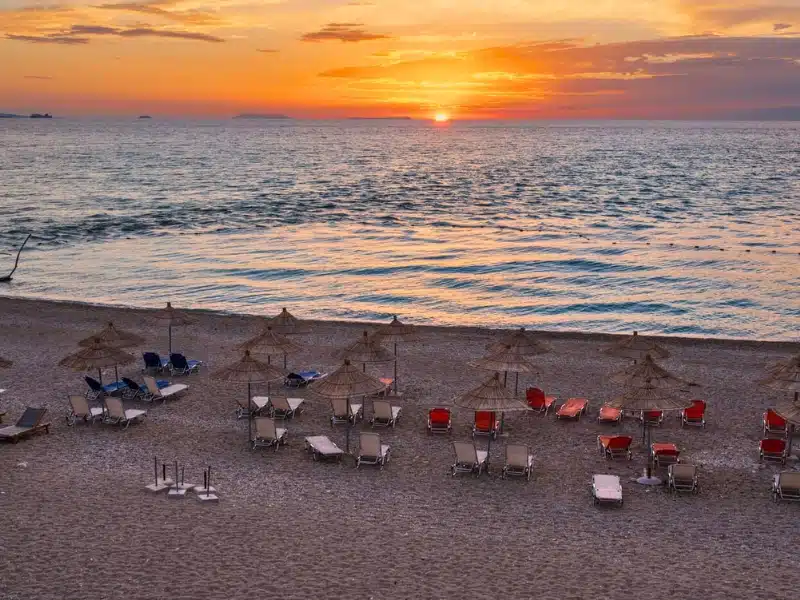
Want to plan your own road trip? Get our step-by-step road trip planning guide to help you organize the perfect trip, or check out our Europe road trip ideas.
Day 4: Sarandë to Muzinë
Ksamil
Ksamil is a picturesque village located just a 20-minute drive south of Sarandë, renowned for its pristine beaches, translucent turquoise waters, and laid-back island charm. Nestled along the Ionian Sea, Ksamil is one of the most beautiful and sought-after destinations along the Albanian Riviera.
Begin your adventure by exploring the Ksamil Islands, a group of four small, lush islands just off the coast. Easily reachable by boat or kayak, these islands boast idyllic beaches, crystal-clear waters, and panoramic views that feel like a slice of paradise. Spend your day swimming, sunbathing, or simply enjoying the serene beauty of this unspoiled natural wonder.
Back on the mainland, indulge in Ksamil’s most popular beaches, including Pasqyra Beach, Puerto Rico Beach, and Lori Beach. Each beach offers its own unique atmosphere, from the vibrant and lively Pasqyra Beach to the more tranquil Lori Beach. Whether you’re looking to relax under the sun or dive into adventure, there are plenty of opportunities for watersports like snorkeling, kayaking, and paddleboarding. Equipment rentals and lessons are readily available for those eager to explore the azure waters.
For a touch of history, visit the Ali Pasha Castle, a 19th-century fortress perched on a hill overlooking Ksamil. Built by the legendary Ali Pasha of Tepelena, the castle provides not only a glimpse into the region’s storied past but also stunning panoramic views of the surrounding countryside and the glittering Ionian Sea.
Another must-see historical landmark is the Butrint Ancient Theater, located within the Butrint National Park, a UNESCO World Heritage Site. Dating back to the 3rd century, this remarkably well-preserved theater features several inscriptions carved into its stones, serving as a testament to the grandeur of the ancient city of Butrint. Walking through its ancient corridors, you can almost hear echoes of the performances that once entertained crowds centuries ago.
While in Ksamil, take time to stroll through the charming village itself. With its narrow streets, traditional houses, and welcoming locals, Ksamil offers an authentic glimpse into Albanian life away from the bustling tourist spots.
Ksamil is also known for its seafood, with local restaurants serving some of the freshest dishes along the coast. Treat yourself to a meal at Abiori Bar Restaurant Pizzeria or The Mussel House Restaurant, both renowned for their delicious seafood platters and relaxed beachfront ambiance.

Muzinë
Muzinë is a charming, small village at the foot of the Gribe Mountains, offering visitors a peaceful retreat surrounded by lush greenery and rugged landscapes. As you travel toward Muzinë, make sure to stop at the Manastiri I Shën Nikollës monastery. This historic site boasts both impressive exterior architecture and beautiful interiors adorned with intricate frescoes, providing a fascinating glimpse into Albania’s religious heritage.
The most popular tourist attraction near Muzinë is the Blue Eye water spring, or Syri i Kaltër – a mesmerizing natural phenomenon not to be confused with the similarly named Blue Eye in Theth. There are, in fact, two official Blue Eyes in Albania, each with its own unique beauty.
Part of the Blue Eye Nature Preserve, this spring is famous for its vivid, crystal-clear blue water that bubbles up from a depth of over 50 meters (164 feet). The water’s striking coloration and purity make it a breathtaking sight. The spring is surrounded by dense forest, creating a serene, almost otherworldly atmosphere.
Reaching the Blue Eye involves an hour’s walk from the parking lot and back, or you can grab a buggy or esccoter at the car park. Make sure to set aside at least two or more hours to fully appreciate your time spent at the spring. Many visitors choose to relax by the water’s edge, while some brave the icy temperatures for a quick, refreshing dip.
Although Muzinë is a small village, you can still find a taste of traditional Albanian hospitality and cuisine. Stop by Taverna Mouzina, a cozy restaurant offering a delightful selection of Greek and Mediterranean dishes. Its welcoming atmosphere and hearty meals make it a perfect place to unwind and refuel after exploring the area.
Where to Stay in Muzinë
Mid-Range: Stay at Margaret’s Guest House for its warm, welcoming atmosphere, cozy rooms, and personalized service. Situated in the quiet village of Muzinë, it offers a peaceful retreat with scenic views of the Gribe Mountains and easy access to nearby attractions like the Blue Eye water spring.
Budget: Stay at Hotel Mesopotami for its spacious rooms, modern amenities, and prime location near Muzinë’s key attractions.
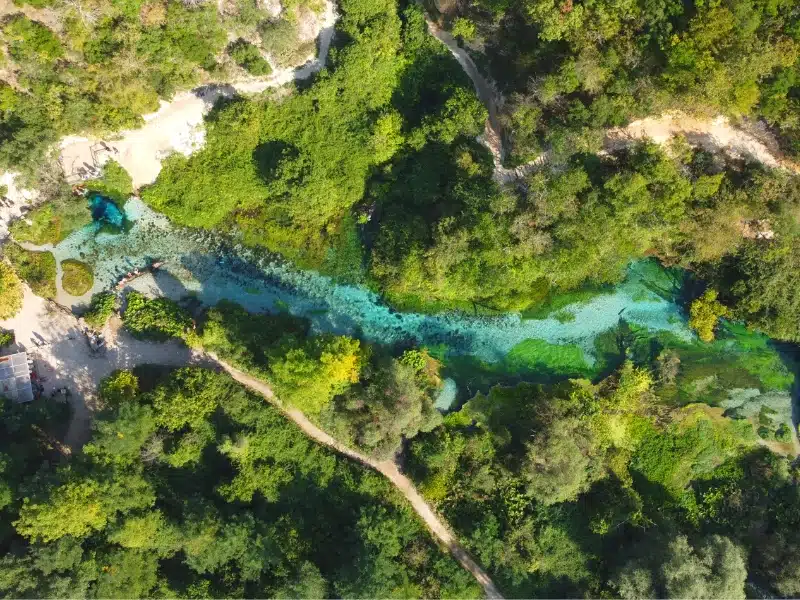
Looking for the best SIM card deals in Europe for your trip? Check out our guide to the best data SIMs in Europe and get the best deal for your trip to Albania.
Day 5: Muzinë to Gjirokastër
Gjirokastër
About an hour from Muzinë is the popular town of Gjirokastër, where you’ll feel as if you’ve been transported back in time. Perched high above the town is the majestic Gjirokastër Fortress that not only offers panoramic views of the surroundings but also allows you to immerse yourself in centuries of turbulent history.
The castle’s intricate architecture and the haunting stories that echo within its walls make it a must-visit attraction. From medieval battles to more recent conflicts, the fortress has witnessed it all. Today, it also houses a military museum and displays various artifacts, including artillery used during World War II.
Below the fortress, the old town of Gjirokastër invites you to explore its distinct cobbled streets lined with charming handicraft shops and traditional restaurants. Be sure to try tavë kosi, a local delicacy made of lamb baked with yogurt, eggs, and rice—an unforgettable dish that Gjirokastër is particularly known for.
Gjirokastër itself is one of the most well-preserved Ottoman towns in Albania and a UNESCO World Heritage Site. The city’s unique architecture, with its characteristic stone houses and wooden facades, adds to the atmosphere of stepping into a bygone era. As you wander through the bazaar area, the old wooden houses, artisan shops, and welcoming cafes create a sense of timelessness that’s both charming and fascinating.
Gjirokastër is also notable as the birthplace of the controversial communist leader Enver Hoxha. You can visit the house where he was born, now converted into an ethnographic museum that provides insight into both his life and the traditional lifestyle of the region.
Where to Stay in Gjirokastër
Upmarket: Stay at Kerculla Resort for its breathtaking hilltop location, luxurious amenities, and spectacular panoramic views of Gjirokastër and the Drino Valley. With a stylish pool area, elegant rooms, and an on-site restaurant serving local specialties, it’s an ideal spot for relaxation and refined comfort after a day of exploration.
Mid-Range: Stay at Palorto Traditional Hotel for its authentic Ottoman-style architecture, charming atmosphere, and welcoming hospitality. Located in the historic Palorto Quarter, this beautifully restored guesthouse offers a genuine Gjirokastër experience with cozy rooms featuring traditional decor and easy access to the Old Bazaar and Gjirokastër Castle.
Budget: Stay at Aria Guesthouse for its friendly ambiance, convenient location, and beautifully decorated rooms. Set in a peaceful area near the town’s historic sites, it offers a comfortable retreat with delightful views of the surrounding hills and easy access to local restaurants and shops.
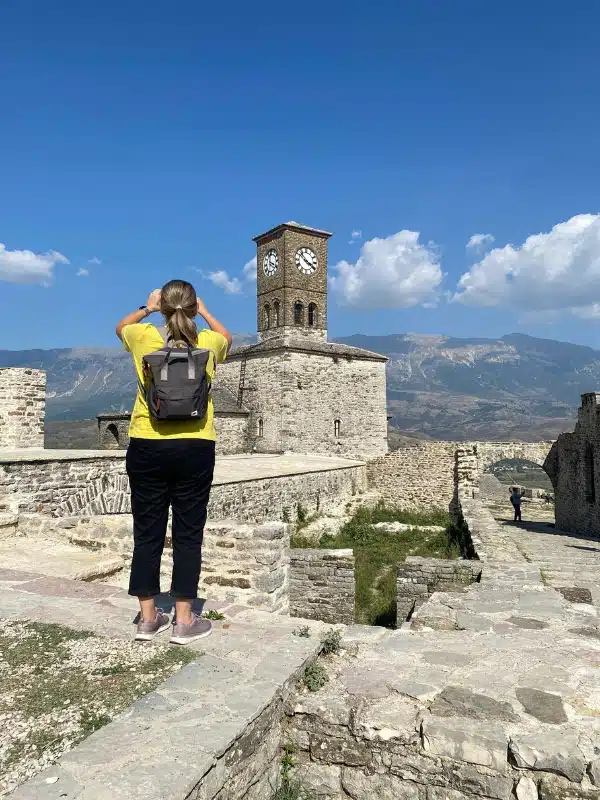
Day 6: Gjirokastër to Përmet
Përmet
Përmet, nicknamed ‘The Hero City’, is a charming town located 55 miles north of Muzinë. Known for its beautiful natural scenery, hot springs, and one very large stone, it offers a unique blend of history and natural beauty.
The City Stone is a striking rock formation that stands at 42 meters (138 feet) high, with a top surface spanning 650 square meters. This impressive site is home to an archaeological area believed to date back as far as the 4th century.
Stories about the City Stone have been passed down in Përmet for generations, and many locals believe that the town was named after a hero from the Middle Ages called Premt. According to legend, Premt was the ruler of the fortress atop the City Stone. When the town was invaded, he chose to throw himself from the stone rather than face capture or death at the hands of the enemy.
While in Përmet, make sure to explore the Old Bazaar. This bustling area is perfect for discovering the town’s traditional culture and crafts. Browse through shops offering handmade jewelry and textiles, or sample traditional Albanian delicacies and snacks from local vendors. It’s an excellent spot to pick up authentic souvenirs and experience the vibrant local atmosphere.
A short walk from the old city, you’ll find the magnificent Kisha e Shën Kollit, or St Nicholas Church. This historic structure features impressive stonework and offers stunning views of the surrounding landscape, making it a worthwhile stop during your visit.
End your day with a delicious dinner at Bar Restaurant Sofra Permetare or Villa Permet Restaurant, both of which serve flavorful local cuisine that showcases the rich culinary traditions of the region.
Where to Stay in Përmet
Upmarket: Stay at Hotel Hymeti’s Palace for its elegant and modern amenities, comfortable rooms, and excellent service. Conveniently located near the center of Përmet, it offers beautiful views of the Vjosa River and easy access to the town’s main attractions, making it a perfect base for exploring the area.
Mid-Range: Stay at The Mosaic House for its charming atmosphere, artistic decor, and welcoming hospitality. This boutique accommodation offers a cozy and stylish experience with a focus on local art and culture, providing guests with a truly authentic stay in Përmet.
Budget: Stay at Vila Culli for its friendly ambiance, traditional design, and convenient location. With its rustic decor and homely feel, this guesthouse provides a relaxing and comfortable experience, ideal for those looking to explore Përmet’s natural and cultural sites.

Lengorica Canyon
A popular activity among visitors is the Bënja thermal baths, located a few kilometers outside town at the entrance to the magnificent Lengorica Canyon, which is guarded by an ancient Roman bridge. The natural hot springs are known for their healing properties and are surrounded by stunning mountain views.
There are several pools close to the bridge, but if you venture on foot into the canyon, you can discover more secluded hot spots nestled at the bottom of the towering walls. The serene atmosphere, warm mineral-rich waters, and breathtaking scenery make it a perfect place to relax and unwind.
For those seeking adventure, rafting expeditions on the mighty Vjosa River are another exciting option. The river, often called Europe’s last wild river, offers thrilling rapids and beautiful natural landscapes. Albturist Eco Camping provides guided rafting tours from Përmet, promising an unforgettable experience for adrenaline enthusiasts and nature lovers alike.
A popular activity among visitors is the Bënja thermal baths, located a few kilometers outside town at the entrance to the magnificent Lengorica Canyon, which is guarded by an ancient Roman bridge. The natural hot springs are known for their healing properties and are surrounded by stunning mountain views.
There are several pools close to the bridge but venture on foot into the canyon for secluded hot spots at the bottom of the towering walls.
Adrenaline hunters can also pick up rafting expeditions on the mighty Vjosa River from Përmet. Try Albturist Eco Camping for an unforgettable experience.
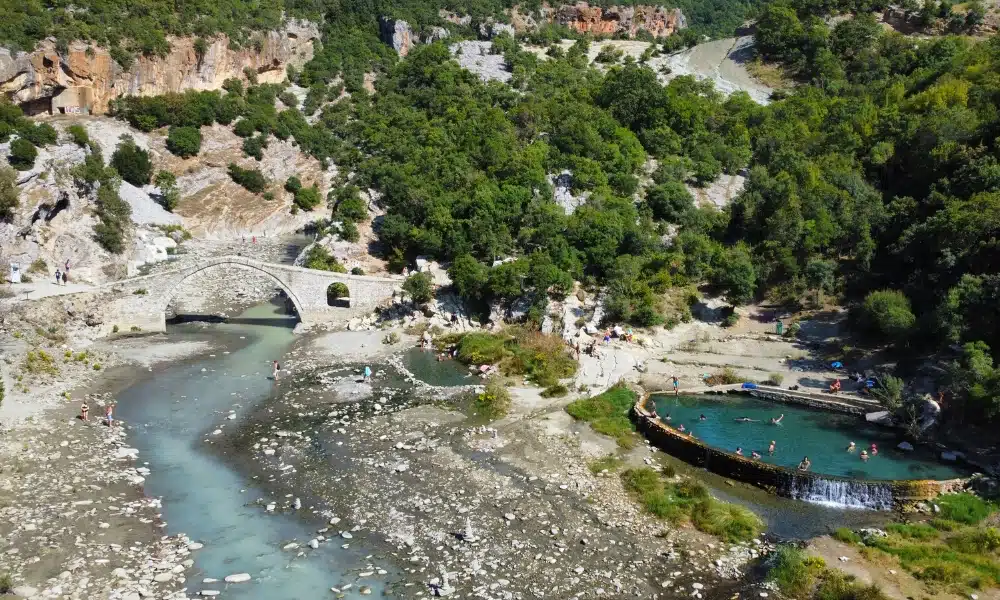
Day 7: Përmet to Tirana
Pogradec
Pogradec is a charming lakeside town located just over 100 miles from Përmet, renowned for its tranquil atmosphere, natural beauty, and cultural heritage. As you travel toward Pogradec, consider stopping at Villa Teo, a cozy retreat where you can enjoy refreshments and relax before continuing your journey.
Gorgeous Lake Ohrid is a UNESCO World Heritage Site and one of Europe’s oldest and deepest lakes. Its crystal-clear waters stretch across the border between Albania and North Macedonia, creating a spectacular natural backdrop that feels almost timeless.
Take a leisurely stroll along the lakeside promenade, a popular spot for both locals and visitors. The walkway is lined with vibrant cafés, restaurants, and shops, offering picturesque views of the shimmering lake against a backdrop of rolling hills and distant mountains. As you walk, you might catch glimpses of local fishermen in their traditional wooden boats or families enjoying the serene beauty of the water.
If you’re eager to dive into Pogradec’s rich history, make sure to visit the 13th-century Saint Naum Monastery, located on the North Macedonian side of Lake Ohrid but accessible via boat trips from Pogradec. This beautiful Orthodox monastery, dedicated to Saint Naum of Ohrid, is renowned for its Byzantine architecture, serene gardens, and vibrant frescoes. The nearby Springs of Saint Naum, with their tranquil, emerald-green waters, offer another unforgettable experience.
Back in Albania, a short drive from Pogradec will take you to the Monumental Tombs of Lower Selca, a fascinating archaeological site dating back to the 4th century BCE. These ancient Illyrian tombs are carved directly into the rock and provide a glimpse into the sophisticated burial practices of the region’s earliest inhabitants. The site’s elevated location also offers sweeping views of the surrounding countryside.
For adventure seekers, the Pogradec Panoramic Viewpoint is a must-see. A hike up to this viewpoint rewards you with breathtaking vistas of the town, the expansive lake, and the lush greenery surrounding it. It’s the perfect place to capture unforgettable photographs and take in the serene beauty of this enchanting region.
Pogradec is also famous for its culinary offerings, particularly the local specialty, Koran fish, which is a rare species found only in Lake Ohrid. Be sure to sample it at one of the town’s traditional restaurants along the promenade.
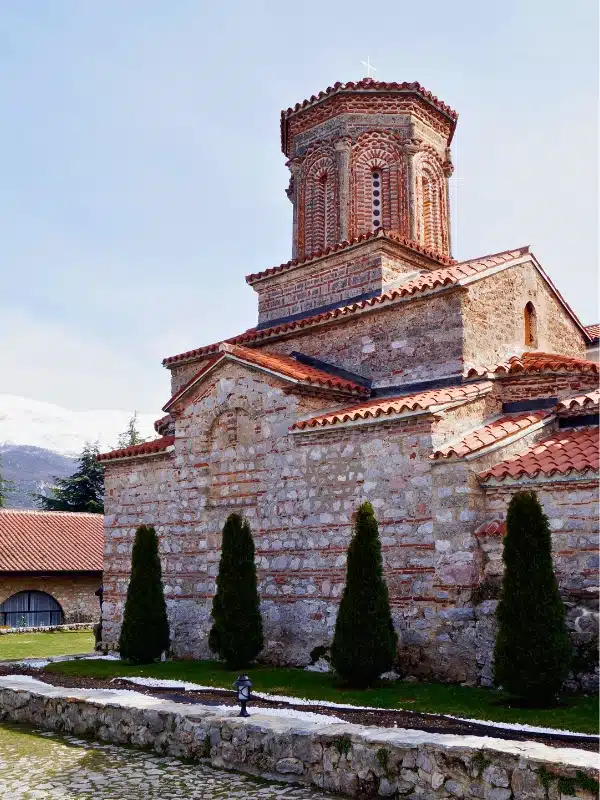
Krujë
About an hour north of Tirana lies the historic city of Krujë, a place steeped in legend and national pride. Deep among rugged hills with sweeping views of the Adriatic coast, Krujë is best known for its castle, bustling bazaar, and deep association with Albania’s national hero, Gjergj Kastrioti, better known as Skanderbeg.
Begin your visit with a climb to the 5th-century Krujë Castle, a fortress that has withstood countless sieges and remains one of Albania’s most cherished historical sites. The castle offers panoramic views of the surrounding landscape, stretching from the vibrant city below to the shimmering coastline in the distance. Within its walls lies the Skanderbeg Museum, dedicated to Albania’s greatest hero who famously led a decades-long rebellion against the Ottoman Empire in the 15th century. Artifacts, paintings, and manuscripts illustrate the dramatic story of his resistance and the indomitable spirit of the Albanian people.
While on the castle grounds, don’t miss the Ethnographic Museum, housed in a charming 18th-century Ottoman-style building. Here, you can delve into Albania’s rich cultural heritage, exploring exhibits featuring traditional clothing, handcrafted tools, elaborate woodwork, and domestic items that provide a glimpse into everyday life centuries ago. The museum’s architecture alone is worth admiring, with its intricately carved ceilings and stone walls offering a beautiful example of local craftsmanship.
Just below the castle, the Old Bazaar unfolds like a journey back in time. Its narrow, cobbled streets are lined with colorful shops and stalls, where artisans sell hand-woven carpets, silver jewelry, traditional costumes, hand-thrown ceramics, and antique artifacts. It’s a vibrant marketplace buzzing with energy and alive with the scents of traditional Albanian food.
Make sure to visit the Dollma Teqe, a Bektashi shrine nestled at the foot of the castle. Known for its beautiful architecture and peaceful atmosphere, this spiritual site offers insight into Albania’s diverse religious heritage. Its tranquil garden provides a quiet retreat from the bustling bazaar, perfect for a moment of reflection.
When hunger calls, sample the best of traditional Albanian cuisine at Rooms & Restaurant Emiliano (Krujë Castle) or Restaurant Bardhi . Be sure to try byrek, a delicious meat and cheese-filled pastry; tave kosi, a creamy lamb and yogurt dish often described as Albania’s national comfort food; and baklava, a decadent dessert made with honey, filo pastry, and nuts. Each dish tells a story of the region’s rich culinary traditions and is sure to leave you wanting more.
If you’re following the seven-day itinerary, Krujë marks the end of your journey as you head back to Tirana for your flight home. However, if you’re on the ten-day road trip, keep reading – there’s still lots more to discover on your Albanian adventure.
Where to Stay in Krujë
Upmarket: Stay at Kruja Albergo Diffuso for a truly unique and immersive experience. This charming, scattered hotel offers beautifully restored rooms spread across several historic buildings within Krujë’s old town. Combining rustic elegance with modern comforts, it provides guests with an authentic feel of the area’s rich heritage and stunning views of Krujë Castle and the surrounding hills.
Mid-Range: Stay at Rooms Merlika for its warm hospitality, comfortable accommodations, and prime location just steps away from Krujë Castle. Set in a traditional stone building, the guesthouse offers breathtaking views of the town and countryside, along with cozy rooms that blend classic decor with contemporary amenities.
Budget: Stay at Villa Duka for its welcoming atmosphere, spacious rooms, and excellent service. Located near the Old Bazaar, it offers convenient access to the town’s main attractions.
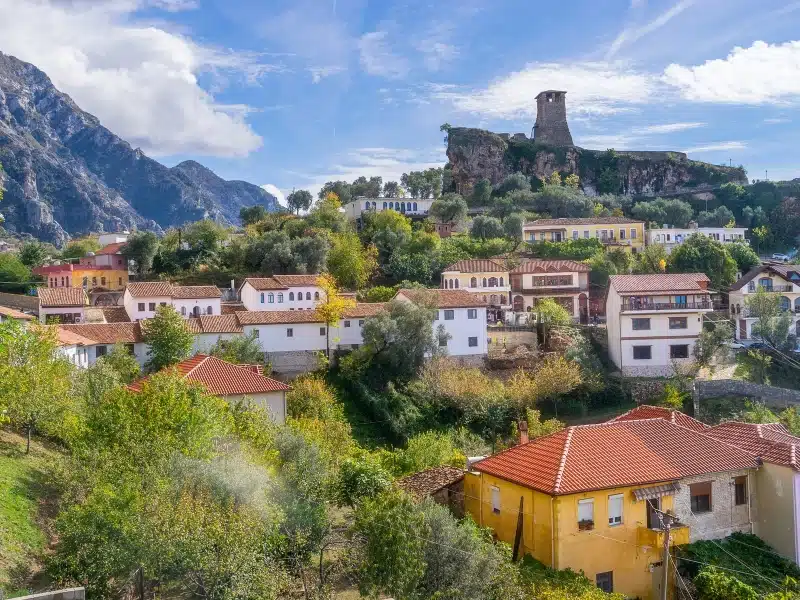
Don’t forget your road trip essentials! Our free road trip checklists help you remember everything, including road trip snacks, podcasts, and road trip songs for the journey!
Day 8: Krujë to Theth
Shkodër
The historic city of Shkodër is a blend of rich culture, ancient legends, and stunning natural beauty. As one of Albania’s oldest cities, it offers visitors a fascinating glimpse into the country’s diverse history and vibrant local life.
Begin your exploration in Shkodër’s historic center, where charming streets are lined with beautiful Ottoman-era architecture. As you wander through the bustling town, you’ll encounter a blend of cultures and styles that reflect Shkodër’s role as a crossroads of civilizations over the centuries.
Stop by the Ebu Beker Mosque, an elegant example of Islamic architecture that has served the local community since its construction in the early 1990s. Then, make your way to the Marubi National Museum of Photography, a true treasure trove for history enthusiasts. With over 500,000 photographs on display, including rare historical images of Albania, this museum offers a remarkable visual journey through the country’s past.
A short walk away, St. Stephen’s Catholic Cathedral, or simply Shkodër Cathedral, stands as an impressive testament to neoclassical architecture. Its grand façade and serene interior provide a peaceful escape from the bustling city streets.
No visit to Shkodër would be complete without a trip to Rozafa Castle, a majestic fortress perched on a hill overlooking the city and the shimmering waters of Lake Shkodër. As you explore its ancient stone walls and sweeping viewpoints, you’ll uncover the dramatic legend of Rozafa—a woman who, according to folklore, agreed to be buried alive within the castle walls to ensure its stability. The haunting tale is commemorated by a statue of Rozafa on the castle grounds, adding a touch of mystery to the breathtaking scenery.
For a culinary treat, enjoy lunch or dinner at Bar Restaurant Elita or Puri, where you can indulge in local dishes that showcase the region’s unique flavors. Whether you’re sampling fresh fish from Lake Shkodër or savoring traditional Albanian specialties, the dining experience is sure to leave you satisfied.
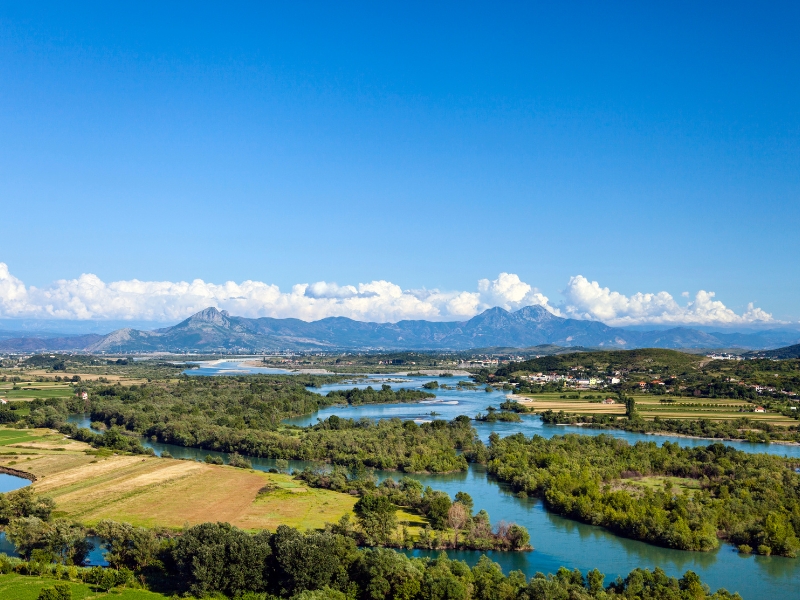
Theth
Theth is a breathtaking alpine village nestled high in the rugged Albanian Alps, famously known as the Accursed Mountains – a name that hints at both their wild beauty and unforgiving nature. Just a two-hour drive from Shkodër, reaching Theth feels like entering another world where dramatic landscapes and untamed wilderness dominate the scenery.
The drive itself is part of the adventure. As you leave the city behind, the road begins to weave through deep valleys, dense forests, and jagged peaks. The route to Theth from Shkodër is nothing short of spectacular, with sweeping views that unfold around every hairpin bend. Although the road is now fully paved – a vast improvement from the rocky, rutted tracks of the past – you’ll still want to take it slow. Sharp switchbacks, steep drops, and narrow passes demand your full attention, but the journey rewards you with vistas that seem pulled from a postcard.
The rugged charm of the Albanian Alps is best experienced between late spring and early autumn. Due to heavy snowfall and treacherous conditions, the road to Theth is closed from November to May each year. Planning your trip during the summer or early autumn ensures not only safe passage but also the chance to witness the mountains in all their glory – lush green meadows, cascading waterfalls, and crystal-clear rivers glinting under the sun.
Theth feels like a well-kept secret, tucked away in a remote corner of Albania where nature reigns supreme and whether you’re seeking adrenaline-fueled hikes or simply looking to disconnect and immerse yourself in the serenity of the mountains, Theth promises an unforgettable experience.
Where to Stay in Theth
Upmarket: Stay at Hotel Kulla e Bajraktarit for a truly authentic experience in the heart of Theth. Housed in a beautifully restored traditional stone tower, this guesthouse offers rustic charm paired with modern comforts.
Mid-Range: Stay at North Alpine Villas for luxurious comfort amid the wild beauty of the Albanian Alps. These elegant villas are designed with a blend of contemporary style and local architecture, offering spacious rooms, private balconies, and panoramic views of the surrounding peaks.
Budget: Stay at Molla Guest House for its welcoming ambiance, charming decor, and friendly hosts. Located near the center of Theth, this cozy guesthouse offers comfortable rooms and hearty home-cooked meals that showcase the best of traditional Albanian cuisine.

Day 9: Theth
The mountain village of Theth is a paradise for hikers and nature enthusiasts, tucked away in the remote heart of the Albanian Alps. Surrounded by jagged peaks, lush valleys, and crystal-clear rivers, Theth feels like an untouched corner of the world where adventure and tranquility go hand in hand.
Nature here doesn’t just impress – it overwhelms. The breathtaking Blue Eye of Theth is a perfect example. Fed by a waterfall from the Limi i Zi or Kaprreja River, the Blue Eye’s vibrant turquoise waters sparkle like a hidden gem nestled in the wilderness. Unlike the more famous Blue Eye near Sarandë, this natural wonder remains off the beaten path, rewarding those willing to venture further with pristine beauty and solitude.
Getting to the Blue Eye is part of the experience. Most hikers tackle the 15.6km (9.7 mile) round-trip trek that follows the river through verdant forests and alpine meadows. It’s not a particularly difficult route with minimal elevation gain, but it’s long, so be sure to bring plenty of water and a hearty sense of adventure. For those looking to shave some time off their journey, a taxi ride from Theth to Nderlysaj shortens the hike to about 30 to 40 minutes one way.
At the trailhead near Ndërlysaj, rustic restaurants and bars overlook the river, inviting you to refuel with a drink or a meal before crossing the quaint Ndërlysaj Bridge to pick up the 30-40 minute Vaskat Ndërlysaj hiking trail. This path winds through thick woodland, where sunlight filters through the canopy to create dazzling patches of light and shade. The terrain is varied – expect to navigate rocky steps, tree roots, and narrow dirt tracks. After heavy rain, the trail can be slippery, so sturdy shoes are essential.
But there’s more to Theth than just nature’s grandeur. The Grunas Waterfall is another highlight, crashing down from a height of 30 meters (100 feet) into a pristine pool below. The hike to the falls is a journey through some of the most picturesque scenery in the region, offering countless opportunities for photography and quiet contemplation.
History and culture are woven into the landscape, too. The Church of Theth, Kisha e Thethit, with its iconic pointed roof and rustic stone walls, sits serenely against a dramatic mountain backdrop. The simplicity of its design feels almost poetic, especially when mist rolls down from the peaks and settles around its steeple.
Nearby, you’ll find the Lock-in or Blood Tower of Theth, a relic of Albania’s turbulent past and a testament to its unique cultural heritage. This 17th-century tower was traditionally used to house those who had violated the Kanun of Lekë Dukagjin – a medieval code of laws governing everything from honor to property disputes. To stand within its stone walls is to touch a piece of Albania’s complex history.
For a true taste of Theth, enjoy a hearty meal at Villa Gjecaj Restaurant or Jezerca Restaurant, where local dishes are served with flair. From grilled meats and fresh vegetables to homemade bread and delicious byrek, every dish tells a story of tradition and hospitality.
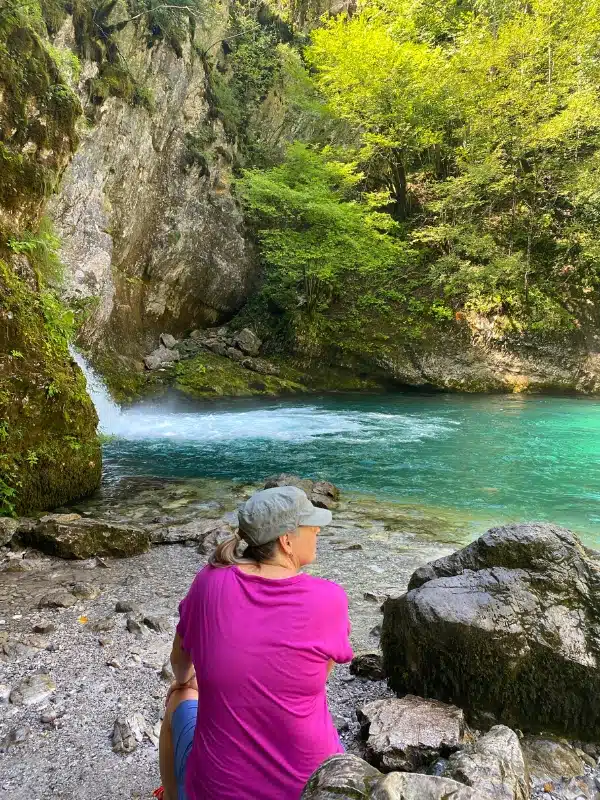
Day 10: Theth to Tirana
The final day of your road trip sees you heading down the mountain from Theth. If you have more time and your own or a hire car, the countries of Montenegro, Greece, Serbia, Kosovo, and even Italy are all within easy striking distance.
Albania Trip Planning Resources
Getting to Albania
Whether you’re traveling to Albania in a car, motorcycle, or campervan from Europe, or picking up a hire car, self-driving is absolutely the best way to explore this fantastic Balkans country.
You can stop whenever you want, try new activities, visit places you see along the route, and have the freedom to change plans at the last minute.
Fly into Albania’s Tirana International Airport (Nënë Tereza). With direct flights from Europe, it’s easy to connect with the States, Middle East and the UK. We recommend booking through Skyscanner for live deals and the best prices.
Are you planning to rent a car in Albania? As one of the largest car hire aggregator companies in the world, we recommend Rentalcars.com because they have massive purchasing power which enables them to secure the best rental car prices, which benefits you when you’re planning a road trip.
For a real adventure, hire a motorhome or campervan in Albania. We recommend AutoEurope for their large range of fully equipped vehicles, competitive pricing and great customer service. Use the Park4Night app to find overnight spots and campsites along the route.
Traveling & Driving in Albania
If you are a confident driver, you shouldn’t find it too difficult to drive in Albania. However, you should be aware that Albanian drivers can be quite erratic, and not all of the roads are paved or kept in good condition, especially in rural areas, although their motorway network is reasonably well maintained.
Whether you’re traveling in your own car, touring Albania in a motorhome, or flying in and renting a car for a driving tour, you need to follow these rules on your Albania roadtrip.
Documents
Rules of the Road
Best Time for Visiting Albania
Spring
Spring in Albania lasts from mid-February until mid-April. The early spring weather is mostly rainy and cold, with temperatures starting to warm up from mid-March. The wildflowers begin to bloom and the mountain landscape comes alive, making late spring one of the best times to visit Albania.
Summer
Summer months in Albania often bring heat and drought. During the summer the sky is usually very clear and rain is pretty much non-existent except for some mountain areas, where the average July temperatures are a pleasant 23ºC / 73ºF.
Fall
Autumn in Albania is quite short and begins in late October, lasting little over a month. It often rains in the fall, but it’s not cold, with the average temperature being a mild 18ºC / 64ºF. The fall colors will be spectacular and Albania’s autumn fruits and nuts are at their peak during this harvesting season.
Winter
Winters in Albania are seriously cold and wet. It snows and rains right across the country and the coldest month of January only manages average daily temperatures of 7ºC / 45ºF at sea level and between minus 12-20ºC / 10 to -4ºF in the mountains! Winter is definitely not our favorite time to road trip Albania!

Looking for more Albanian travel ideas? Check out these top posts…
Europe’s Best Kept Secrets: Unique Travel Destinations to Visit in 2026
11 European Cities You’ve Never Heard Of But Should Visit
Is Albania Safe? A Comprehensive Guide for Adventurous Travelers
Is Tirana Worth Visiting? Top Reasons to Explore the Lively Albanian City
Driving in Albania: Essential Tips for an Amazing Trip
Blue Eye Albania: Visit Sarandë & Theth Natural Pools
Love it? Pin it!
